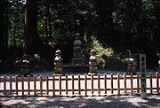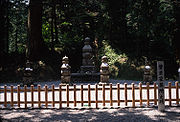
Toyotomi Hideyori
Encyclopedia


Toyotomi Hideyoshi
was a daimyo warrior, general and politician of the Sengoku period. He unified the political factions of Japan. He succeeded his former liege lord, Oda Nobunaga, and brought an end to the Sengoku period. The period of his rule is often called the Momoyama period, named after Hideyoshi's castle...
, the general who first united all of Japan
Japan
Japan is an island nation in East Asia. Located in the Pacific Ocean, it lies to the east of the Sea of Japan, China, North Korea, South Korea and Russia, stretching from the Sea of Okhotsk in the north to the East China Sea and Taiwan in the south...
. His mother, Yodo-dono
Yodo-Dono
or was a prominently-placed figure in late-Sengoku period. She was a concubine and second wife of Toyotomi Hideyoshi, who was then the most powerful man in Japan. She also became the mother of his son and successor, Hideyori. She was also known as Lady Chacha...
, was the niece of Oda Nobunaga
Oda Nobunaga
was the initiator of the unification of Japan under the shogunate in the late 16th century, which ruled Japan until the Meiji Restoration in 1868. He was also a major daimyo during the Sengoku period of Japanese history. His opus was continued, completed and finalized by his successors Toyotomi...
.
When Hideyoshi died in 1598, the regents
Council of Five Elders
The council of five elders, also known as the five Tairō , was formed by Toyotomi Hideyoshi to rule Japan in the place of his son, Hideyori, until such time as he came of age. Hideyoshi chose his five most powerful daimyo: Ukita Hideie, Maeda Toshiie, Uesugi Kagekatsu, Mōri Terumoto, and the...
he had appointed to rule in Hideyori's place began jockeying amongst themselves for power. Tokugawa Ieyasu
Tokugawa Ieyasu
was the founder and first shogun of the Tokugawa shogunate of Japan , which ruled from the Battle of Sekigahara in 1600 until the Meiji Restoration in 1868. Ieyasu seized power in 1600, received appointment as shogun in 1603, abdicated from office in 1605, but...
seized control in 1600, after his victory over the others at the Battle of Sekigahara
Battle of Sekigahara
The , popularly known as the , was a decisive battle on October 21, 1600 which cleared the path to the Shogunate for Tokugawa Ieyasu...
. Hideyori's arranged marriage to Senhime
Senhime
Senhime or Lady Sen was the eldest daughter of the shogun Tokugawa Hidetada and his wife Oeyo. She was born during the warring-states period of Japanese history...
, the seven-year-old granddaughter of Ieyasu, was designed to mitigate Toyotomi clan dissension and plotting. In this period, the eight-year-old boy practiced calligraphy with phrases wishing for peace throughout the world. However, Ieyasu continued to view the young Hideyori as a potential threat.
Tokugawa forces attacked Hideyori in the Siege of Osaka
Siege of Osaka
The was a series of battles undertaken by the Tokugawa shogunate against the Toyotomi clan, and ending in that clan's destruction. Divided into two stages , and lasting from 1614 to 1615, the siege put an end to the last major armed opposition to the shogunate's establishment...
in the winter of 1614. The attack failed, but Hideyori was induced to sign a truce and dismantle the defenses of his stronghold Osaka Castle
Osaka Castle
is a Japanese castle in Chūō-ku, Osaka, Japan.Originally called Ozakajō, it is one of Japan's most famous castles, and played a major role in the unification of Japan during the sixteenth century of the Azuchi-Momoyama period.-Description:...
.
In April 1615, Ieyasu received word that Toyotomi Hideyori was gathering even more troops than in the previous November, and that he was trying to stop the filling of the moat of Osaka Castle
Osaka Castle
is a Japanese castle in Chūō-ku, Osaka, Japan.Originally called Ozakajō, it is one of Japan's most famous castles, and played a major role in the unification of Japan during the sixteenth century of the Azuchi-Momoyama period.-Description:...
. Toyotomi forces (often called the Western Army) began to attack contingents of the Shogun's forces (the Eastern Army) near Osaka. On June 5, 1615. As Toyotomi's forces began to lose the battle, a smaller force led directly by Hideyori sallied forth from Osaka Castle too late, and was chased right back into the castle by the advancing enemies. There was no time to set up a proper defense of the castle, and it was soon set ablaze and pummeled by artillery fire. Hideyori and his mother committed seppuku
Seppuku
is a form of Japanese ritual suicide by disembowelment. Seppuku was originally reserved only for samurai. Part of the samurai bushido honor code, seppuku was either used voluntarily by samurai to die with honor rather than fall into the hands of their enemies , or as a form of capital punishment...
, and the final major uprising against Tokugawa rule for another 250 or so years was put to an end. His widow remarried but later became a Buddhist nun.
Hideyori's son Kunimatsu
Toyotomi Kunimatsu
a member of the Japanese clan of Toyotomi following the Edo period of the 17th century. Kunimatsu was famed for being the son of Toyotomi Hideyori . Following the year of 1615 during the Siege of Osaka, Hideyori ended up having his castle taken by that of Tokugawa Ieyasu, ending in his suicide...
(age 8) was captured and beheaded; his daughter was sent to Tōkei-ji
Tokei-ji
, also known as or ), is a Buddhist temple and a former nunnery, the only survivor of a network of five nunneries called , in the city of Kamakura in Kanagawa Prefecture, Japan. It is part of the Rinzai school of Zen's Engaku-ji branch, and was opened by Hōjō Sadatoki in 1285. It is best known as...
, a convent in Kamakura
Kamakura, Kanagawa
is a city located in Kanagawa Prefecture, Japan, about south-south-west of Tokyo. It used to be also called .Although Kamakura proper is today rather small, it is often described in history books as a former de facto capital of Japan as the seat of the Shogunate and of the Regency during the...
, where she later became the abbess
Abbess
An abbess is the female superior, or mother superior, of a community of nuns, often an abbey....
Tenshū-ni.

